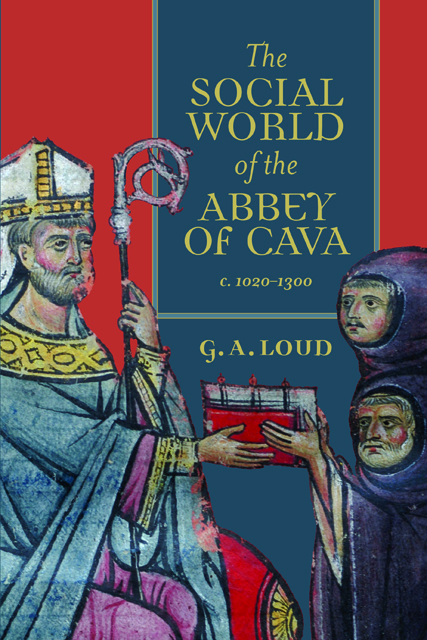Book contents
- Frontmatter
- Dedication
- Contents
- List of Maps and Charts
- Acknowledgements
- List of Abbreviations
- Note on the Organisation and Publication of the Cava Archive
- Dates
- Currency, Weights and Measures
- The Abbots of Cava, c. 1020-1300
- Maps
- I The Family of Vivus Vicecomes
- Introduction
- Part I The Abbey of Cava
- Part II Society and Economy
- Conclusions
- Appendix: Purchase and Expenditure by the Abbey of Cava, at Selected Periods between 1175 and 1230
- Bibliography
- Index
- Other volumes in Studies in the History of Medieval Religion
8 - Administration and Personnel
Published online by Cambridge University Press: 14 January 2023
- Frontmatter
- Dedication
- Contents
- List of Maps and Charts
- Acknowledgements
- List of Abbreviations
- Note on the Organisation and Publication of the Cava Archive
- Dates
- Currency, Weights and Measures
- The Abbots of Cava, c. 1020-1300
- Maps
- I The Family of Vivus Vicecomes
- Introduction
- Part I The Abbey of Cava
- Part II Society and Economy
- Conclusions
- Appendix: Purchase and Expenditure by the Abbey of Cava, at Selected Periods between 1175 and 1230
- Bibliography
- Index
- Other volumes in Studies in the History of Medieval Religion
Summary
The tide of benefactions, and also purchase, under Abbot Peter had by the early twelfth century already created both an ecclesiastical empire and a significant landed lordship, which developed still further over the rest of that century. Cava was not simply a monastery, but the head of a large congregation of monastic cells and other dependent churches, and a landlord on a huge scale. We do not know how large the monastic community was, but if one takes in those monks staffing the principal dependencies and the monastery’s servants, even if the latter were rarely mentioned in the sources, this must have numbered some hundreds of men. In addition, there were thousands of peasant tenants on its lands, as well as a smaller, but far from negligible, number of lessees of urban property. An organisation of such scale required, therefore, an effective and energetic administration, both to ensure an adequate income and, increasingly, to defend the abbey’s property and interests. While sanctity and humility might be the idealised virtues of abbots and monks, what they actually, or also, required were significant practical skills – and for the abbots a combination of competence, authority and diplomacy as the public face of the monastery.
The Abbots
As with many other medieval monastic houses, the abbots of Cava are for the most part only names to us. We can to some extent trace their careers through the charters, although only to a limited extent before they became abbot. But it is only in the case of the early abbots that we can have any impression of their personalities, and even then this is refracted through the hagiographic lens of Peter of Venosa’s Lives of the First Four Abbots. The author’s purpose was, conventionally enough, to hold out these abbots as models for those who came after them: to ‘raise up on high the behaviour of holy men as an example for those less perfect’, that ‘those who follow what was instituted by them may be fired by their example and miracles’. The focus was therefore on the personal qualities of the early abbots, their role in setting an example of holiness and austerity to their monks, and the wonders which validated their saintly status and redounded to the credit of the monastery.
- Type
- Chapter
- Information
- The Social World of the Abbey of Cava, c. 1020-1300 , pp. 231 - 272Publisher: Boydell & BrewerPrint publication year: 2021



